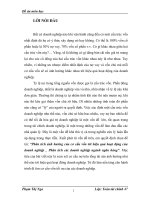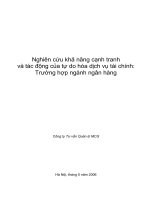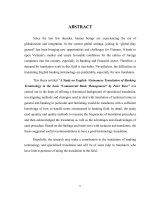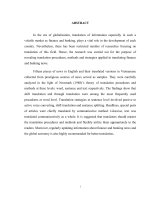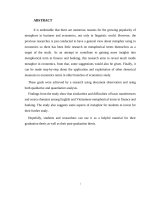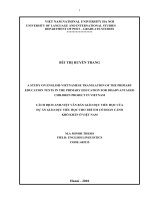1NGHIÊN cứu CÁCH DỊCH ANH VIỆT các THUẬT NGỮ NGÀNH NGÂN HÀNG TRONG CUỐN SÁCH COMMERCIAL BANKS MANAGEMENT của tác GIẢ PETER ROSE
Bạn đang xem bản rút gọn của tài liệu. Xem và tải ngay bản đầy đủ của tài liệu tại đây (564.49 KB, 91 trang )
ABSTRACT
Since the last few decades, human beings are experiencing the era of
globalization and integration. In the current global settings, joining in “global play
ground” has been bringing new opportunities and challenges for Vietnam. It leads to
open Vietnam’s market and create favorable conditions for the entries of foreign
companies into the country, especially in Banking and Financial sector. Therefore, a
demand for translation work in this field is inevitable. Nevertheless, the difficulties in
translating English banking terminology are predictable, especially for new translators.
This thesis entitled “A Study on English- Vietnamese Translation of Banking
Terminology in the book “Commercial Bank Management” by Peter Rose” was
carried out in the hope of offering a theoretical background of specialized translation,
investigating methods and strategies used to deal with translation of technical terms in
general and banking in particular and furnishing would-be translators with a sufficient
knowledge of how to handle terms encountered in banking field. In detail, the study
used quantity and quality methods to measure the frequencies of translation procedures
and then acknowledged the translation as well as the advantages and disadvantages of
each procedure. Based on the findings and interviews with lecturers and translators, the
thesis suggested useful recommendations to have a good terminology translation.
Hopefully, the research may make a contribution to the translation of banking
terminology and specialized translation and will be of some help to translators who
have little experience of doing the translation in the field.
ii
TABLE OF CONTENTS
ABSTRACT ii
TABLE OF CONTENTS iii
LIST OF TABLES vi
LIST OF DIAGRAMS vi
Chapter 1 Introduction 1
1.2.2 Research questions 2
Chapter 2 Literature Review 5
2.1 Terminology 5
2.1.1 Definition 5
2. 2. Translation of Terminology 10
2.2.1 General Translation 10
2.2.1.1 Definition 10
2.2.1.2 Methods of translation 11
2.2.1.3 Procedures of translation 13
2.2.2 Translation of banking terminology 15
2.2.2.1 Overview of technical translation 15
2.2.2.2 Translation of terminology and its roles in technical translation 16
2.2.2.3 Difficulties in terminology translation 16
2.2.2.4 Translation of Banking Terminology 17
Chapter 3 Methodology 19
Chapter 4 Findings 22
4.1 Overview: 22
4.2 Classification of terms in the book “Commercial Banks Management” 22
4.2.1 Simple terms 23
4.2.1.1 Single terms which are Nouns 23
4.2.1.2 Abbreviation: 24
4.2.2 Complex terms: 24
4.2.2.1 The Nominal groups: 25
4.2.2.2 The banking terminology in the forms of Nominal groups: 27
4.2.2.2.1 Terms consisting of Classifier (noun) +Thing 27
iii
4.2.2.2.2 Terms consisting of Classifier / Epithet (adjective) +Thing 28
4.2.2.2.3 Terms consisting of Classifier/Epithet (present participle) +Thing 28
4.2.2.2.4 Terms consisting of Classifier/Epithet (past participle) +Thing 28
4.2.2.2.5 Terms consisting of Thing + Qualifier 29
4.2.2.2.6 Eponym 29
4.3 Translation of collected banking terminology 29
4.3.1 Translation of single terms 31
4.3.1.1 Translation of single terms in the form of nouns by Literal translation procedure 31
4.3.1.2 Translation of single terms in the form of nouns by Paraphrase 32
4.3.1.3 Translation of single terms in the form of nouns by Shift or Transposition Translation
procedure and Functional Equivalent 32
4.3.1.4 Translation of Abbreviation 33
4.3.2 Translation of complex terms 34
4.3.2.1 Translation of Nominal groups using Literal translation Procedure 34
4.3.2.2 Translation of Nominal Groups using Paraphrase 34
4.3.2.3 Translation of Nominal groups using Functional Equivalent 34
4.3.2.4 Translation of Eponym using Couplets translation procedure 35
4.4 Evaluation of terminology translation and translation procedures in the book “Commercial
Banks Management” 35
4.4.1 General evaluation of banking terminology translation 35
4.4.2 Evaluation of the translation procedures 37
4.4.2.1 Literal translation procedure 37
4.4.2.2 Shift or Transposition translation procedure 38
4.4.2.3 Through translation procedure 39
4.4.2.4 Functional Equivalent Translation Procedure 40
4.4.2.5 Paraphrase translation procedure 40
4.4.2.6 Couplets translation procedure 41
4.5 Suggestions and recommendations 41
4.5.1 Suggestions and recommendations based on the evaluation of translation procedures 41
4.5.1 Suggestions and recommendations based on interviews 42
Chapter 5 Conclusion 45
iv
5.1 Summary of the findings 45
5.2 Limitations of the study 46
5.3 Suggestions for further researches 47
REFERENCES 48
APPENDIX 50
v
LIST OF TABLES
Table 1 Nominal group’s structures (Halliday, 1985) 25
Table 2 Items of Nominal group 25
Table 3 Procedures used for each category of terms 31
Table 4 Examples of translation procedures applied for
Abbreviations
33
Table 5 Examples of Couplets translation procedure 35
LIST OF DIAGRAMS
Chart 4.2 Portion of each category of collected terms 23
Chart 4.3 Frequency of each translation procedure 30
vi
vii
Chapter 1 Introduction
1.1 Rationale
Since the last few decades, human beings are experiencing the era of globalization
and integration. A huge number of miracle scientific breakthroughs have completely
changed the people’s lives and brought them much closer. Global competition and
global co-operation, both of which presuppose global communication, now become
common concepts. Also, in the cultural arena, we can trace the development of what is
often called the “global village”, with greatly improved social and cultural contact,
both active and passive. In the other words, the modern advance has turned our planet
into a global village in which people’s rights and obligations are closely related.
In the current global settings, world trade is increasing dramatically, national
barriers seem to fade away, many multinational companies have actively extended their
business to seek new opportunities and make huge profit. Joining “global play
grounds” like the World Trade Organization (WTO) has been bringing new
opportunities and challenges for Vietnam. It leads to open Vietnam’s market and create
favorable conditions for the entries of foreign companies into the country, especially in
Banking and Financial sector. Some global banks such as HSBC, ANZ, City Bank
have established their banking systems and competed against Vietnamese ones.
Therefore, a demand for translation work in this field is inevitable. The problem lies in
the fact that sharp differences in the global banking systems and Vietnamese one result
in several differences in banking documents. Obviously, this will pose a great obstacle
to translators if they do not obtain sufficient knowledge about this field. The mastery of
terminology in this specialized subject and the methods to convert them into
Vietnamese are very helpful in using terms accurately, precisely and with expertise.
This helps translators avoid embarrassing situations when they are confused with new,
strange and difficult terms.
1
Yet despite the overwhelming demand for and the importance of terminology
translation in general and of banking sector in specific, surprisingly little is known
about it because there are no comprehensive studies on this topic. Recently, the book
“Commercial Banks Management” has become a popular course book for banking
students in many universities. The lack of studies on banking terminology translation
and my experience of having studied the translated version of this book lead me to an
idea of making an investigation into how banking terminology is translated. Hopefully,
this thesis entitled “A Study on English- Vietnamese Translation of Banking
Terminology in the book “Commercial Bank Management” by Peter Rose” may be
of some use to those who will do translation in the field.
1.2 Aims and research questions
1.2.1 Aims
In short, the main purpose of this paper is to study English – Vietnamese
translation of banking terminology as a specific and complex issue of language for
special purpose. In this way, focus will be on offering a theoretical background of this
issue, investigating methods and strategies used to deal with translation of technical
terms and furnishing would-be translators with a sufficient knowledge of how to
handle terms encountered in banking field.
1.2.2 Research questions
This paper is conducted to seek answers to the following questions:
1. What are procedures employed to translate banking terminology in the book
“Commercial Banks Management”?
2. What are acknowledgements of translation in general and each translation
procedure in specific?
3. How to improve banking terminology translation skill?
2
1.3 Research Methods
This is a quantitative and qualitative research paper. In order to lay a practical
background for the paper, this session is going to present the research methodology
based on a combination of quantitative and qualitative analysis. Specially, the
procedures of theoretical basic and data collection, data analysis include: (1) Study the
relevant materials of foreign and Vietnamese linguists and synthesize all grounding
associated with translation, language for special purpose, technical terms and banking
terms to form a theoretical background. (2) Collect data: The methods used to obtain
data for my analysis can be accounted for in two separate steps –collect banking
translated terms in the Vietnamese version of the book “Commercial Banks
Management” and set up a glossary of banking terms in both English and Vietnamese
versions. The second step is to identify and categorize translation procedures used
when approaching the different aspects of terminology. (3) Analyze the methods for
terminology translation of banking sector, present the illustration and calculate the
prevalence of each method. (4) Appraise statistics and give further comment on the
efficiency of these methods. (5) Discuss some recommendations for good translations
of banking texts. The recommendations are suggested from analyzing data and
interviewing some lecturers or translators who have worked with banking terminology
translation before.
1.4 Scope of the study
Within limited time, material, and the length of the thesis, the researcher focuses
only on Vietnamese equivalents for banking terms in the book “Commercial Bank
Management” by Peter Rose. These equivalents are collected from the translation made
by Mr. Nguyen Huy Hoang published in 2004. Specifically, the investigation of the
study takes into consideration such major aspects as follows:
• Classification of banking terminology
3
• Structural patterns of English banking terms
• The translation procedures employed.
1.5 Design of the study
The study is divided into five chapters:
Chapter 1: “Introduction”. This is a section which outlines the rationale by
which the author decided to conduct this study as well as the limit within which the
study is conducted. This part also presents some methods for the accomplishment of
the study.
Chapter 2: "Literature Review”. It provides various linguistic concepts which
are necessary for and relevant to the scope of study such as terms, the typical features
of terminology, the definitions of translation, the strategies and procedures of
translation, etc.
Chapter 3 “Methodology” will present methods used in the study. This part
includes research instruments, research procedures, materials for the data collection
and the steps of data analysis.
Chapter 4: “Findings”. It deals with the most important issues of the study. This
chapter mainly focuses on the English- Vietnamese translation of typical banking terms
to draw out the common translation procedures and strategies employed in the
translation. This chapter also makes some suggestions to improve banking terminology
translations.
Chapter 5: “Conclusion” summarizes what is addressed as well as what is not in
the study, implications of the study to the translation of banking terminology from
English into Vietnamese.
4
Chapter 2 Literature Review
2.1 Terminology
2.1.1 Definition
Since the topic of this research is “A Study on English- Vietnamese
Translation of Banking Terminology in the book “Commercial Bank Management”
by Peter Rose”, apparently, the word “terminology” should appeal to any reader who
happens to rest his eyes on this work as the key point of the research. The author of this
research finds essential to satisfy the immediate question undoubtedly raised thereby:
“What is terminology?” There are several ways to explain about “terminology”
according to each specific sector.
According to Cambridge Advanced Learner Dictionary, terminology means
“the special words and phrases used in a particular subject.” And terminology, quoted
from Oxford Advanced Learner Dictionary, is “a set of technical words or expressions
used in a particular subject.” This dictionary also explains that term is “a word or
phrase used as the name of something especially one connected with a particular type
of language.”Therefore, based on the definitions of the second dictionary, terminology
obtains a broader meaning than a term does. While terminology refers to the system of
all concepts and definitions relating to a specific technical area, the other just refers to
discrete entities, or constitutes the knowledge of a particular subject. Thus, defined in a
similar way, banking terminology must be a set of terms concerning about the banking
industry.
As a matter of the fact, terminology has been variously defined by many
scholars, linguists and scientists, either English native speakers or Vietnamese.
Richard, M. (1999:19) defined “term is the particular lexical items appear in a subject
5
or a specialized theme.” Sharing the same content with the one by Richard, the
definition by Giap, N.T (1998) seems to be more detailed: “Terminology, understood
as a special linguistic unit of language, consists of word and fixed phrase that provides
precise definition and objectives that belong to particular scientific area.” According
to Chau, D.H (1981), another Vietnamese linguist, “Terms are specialists of words
used within a specific field, a profession or any technological field.” To add more
information for his concept, he also states: “Scientific and technical terminology
consists of lexical units used to denote phenomenal objects, activities…in industrial
technologies and natural or social sciences.” In Cabré’s study (1999), she emphasizes
on the usage of terminology as “a set of terms in a particular special subject”. In this
sense, terminology is the collection of words which one would normally associate with
a particular discipline. Terms can be any class of words, such as verbs, nouns,
adjectives or adverbs but they are considered to have a clearly defined meaning when
used in the particular field or context for which they have been defined.
The definitions above can be a ground to distinguish terms and words. In
addition, attention can be paid to study of Teresa Cabré (1999) which says: “for
terminology, terms are of interest on their own accounts as opposed to the usage of
words only in context and neither inflection […] nor syntax […] are of consequence.”
She adds another distinction between words and terms: “Pragmatics is the factor that
most significantly differentiates terms from words. Pragmatically, terms and words
differ with respect to their users, the situation in which they are used, the topics they
communicate and the type of discourse in which they usually occur.” A little bit earlier
than Cabré, in 1998, Backer states that: “Terms differ from words in that they are
endowed with special forms of references, namely that they refer to discrete conceptual
entities, properties, activities or relations which constitute the knowledge space of a
particular subject field.” From both points of view and definitions of terms by
scholars, we can see the strong relationship between terms and special fields as well as
6
the roles of terms in these fields. The differences distinguishing terms from words can
be summarized into two features:
o Terms have special reference within a particular discipline while words
perform their functions in general reference over various fields.
o Terms obtain “defined meaning” and keep its meaning in a particular system
of knowledge. Each term denotes a concept in this particular system.
In brief, terms regarded as scientific words, unlike ordinary words which can be
used in every general field. However, the line between terms and words is not always
clear, because, in its specific field, a term is considered as a word.
2.1.2 General characteristics of terminology
While ordinary words can convey more than their literal meaning due to the
images, emotion and reaction of shareholders, terms are not allowed to evoke speaker’s
attitude, figurative senses, prejudices, compliment or criticism. According to Chau,
D.H (1981:34), terminology has to ensure three qualities: Accuracy, Systematicality
and Internationality. Other two linguists, Giap, N.T (1998) and Lang, L.V (1977) share
the same opinion with him but they add two qualities of Popularity and Nationality to
Chau’s criteria. However, due to the limit of thesis, the characteristics of terms defined
by Chau are more referable.
Accuracy
As cited before, the meaning of terms are “defined in particular fields and particular
contexts.” That means a concept which is represented by a term must be clear and
exact. If terms are ambiguous, people will mistake one concept for another. In fact, the
accuracy of terminology is well recognized in both of its form and meaning.
In terms of the lexical meaning of words, normal words often bear the
characteristics of polysemy and synonym, whereas terminology is kept away from
7
them. While the semantic meaning of ordinary words may change in different usage
and context, that of terms is fixed in specialized fields and cannot change in any
context. Taking a normal and simple noun like “school” in general languages for
further understanding, it has up to eight shades of meanings when uses in different
circumstances. Meanwhile, in medicine, the term “pneumonia” is understood for only
one single meaning of “a serious illness affecting one or both lungs that makes
breathing difficult.”
With respect to the accuracy in terms of form, terminology has no other form or
outer cover other than its original one. We are hardly able to change the form of terms
in order to make changes in the word meaning. However, the form of a term could be
changed, but in a special way.
Systematicality
Terminology of a specific profession is a set of terms which are closely related to
the field and to each other. According to Chung, H.T (2005), terms “are subject
related, occurs in a special domain, and it is a part of a system of subject knowledge.”
The relationships among them reflect a system of the concepts in the field and also
contribute to build a strong and solid set of vocabulary. The relationships also
determine the semantic meaning of each term. The system of terms has not only to
meet the requirements of any general vocabulary basket but also to satisfy particular
demand of the field in which it functions. The solid and finite system of concepts of a
specialized field of science is built in that way. Due to such solid relationships among
terms and terms and between terms and set of terms, terms are away of ambiguous
meaning. As Chung, H.T (2005) says “the meanings of technical terms are closely
associated with a particular subject area.” Therefore, once isolated from its
specialized field, terms may be meaningless or obtain an ambiguous meaning. In
addition, the meanings of a term may be different in different fields of science. For
8
example, term “floor” in banking means “tối thiểu” meanwhile, in architecture, it
denotes “sàn nhà”.
In short, systematicality makes terms the dependent insiders of a specialized field
also the builder of the field’s concepts.
Internationality
Like other features, the characteristic of internationality is recognized in both form
and meaning of terminology.
With respect to meaning, terms denote common scientific concepts and share
common meanings which are equally understood by speakers of different cultures. This
feature is very important and helpful to distinguish terminology from other layers of
vocabulary such as slang, dialect, etc. While normal or general lexical items are
confined to limits of expression, context, and difference in culture, terms present
universal concepts of a certain subject.
With regards to internationality in the form, terms keep their form in several
languages. For example, “vitamin” in English is also defined in a similar way in
Vietnamese, German and French. However, some terms such as radio and telephone
are presented with a little difference in form in some languages.
The internationality of terms helps promote global integration in terms of
languages. For example, due to the demand of understanding English Technology
terms, many technology students would like to learn English. Furthermore, because
language is a bridge linking people, the terms contribute to the transfer of science and
technology worldwide.
Terminology on banking also has all characteristics of terminology. These
characteristics described above determine suitable methods applied to English –
Vietnamese Translation of terms.
9
2.1.2 Standards of Vietnamese terminology
The issue of which standards that Vietnamese terminology should follow has
been controversial. In the book “Tiếng Việt và dạy học bằng tiếng Việt” (Vietnamese
and Teaching in Vietnamese), the author Ke, L.K (1967) says that: “in the first place,
terminology should be scientific, accurate, systematic then popular, applicable and
native language in accordance with characteristics of Vietnamese.” However, the
author Thoi, L.V claims that: “a noun that is used in a particular subject must belong
to such fields linguistically and practically, and as concise and simple as possible.” He
also argues that a noun should be monosemy and one concept should be expressed by a
noun.
In 1967, the conference on terminology held in Hanoi by the State Committee of
Science came to a unanimous conclusion that Vietnamese terminology is to be:
systematical, linguistically native, accurate, concise and popular and of great utility.
In brief, Vietnamese terminology shares common characteristics with English
one. It expresses one concept, rarely has synonyms or polysemy and is popular among
its users.
These features of terminology have helped translator a lot in deciding most
suitable methods of translation when it comes to handling difficult terms in technical
translation.
2. 2. Translation of Terminology
2.2.1 General Translation
2.2.1.1 Definition
The demand for communication between human beings is growing more and
more essential as the society becomes more developed. With the speedy development
of communication media, it has not stopped at a national scale but the international
10
one. It is translation that brings one nation, one language, one culture to each other.
The concepts regarding theories of translation have been developed until present to
suggest a satisfactory definition of translation.
Many linguists have defined translation in their own words. According to
Cartford (1965), translation is “the replacement of a text in one language by an
equivalent text in another language.” The following definition: “Translation is the
expression in another language of what has been expressed in another, preserving
semantic and stylistic equivalences” was collected and edited by the author Bell, R.T
(1991:5).
Other authors, Hatim & Mason (1990:3), however, focus more on the
communicative purpose of translation rather than the semantic and stylistic features:
“Translation is a communicative process which takes place within a social context”.
Newmark, P. (1995:7) defines translation as “translation is a craft consisting in
the attempt to replace a written message and statement in one language by the same
message and/or statement in another language.”
Although the above definitions of translation are expressed in different ways,
they share the most common idea. Translation is the art of transferring a picture in one
language into another picture which brings the same message in another language.
2.2.1.2 Methods of translation
Controversy has risen since at least the first century B.C over the issue of
translating literally or freely. As the study of cultural anthropology suggested that the
linguistic barriers are insurmountable, the view that translation must be as literal as
possible gains approval.
Though controversy remains, eight methods of translation proposed by Peter
Newmark, P. (1988:45-47) have been most popular to translators. These methods are:
word-for-word translation, literal translation, faithful translation, semantic translation,
11
adaptation, free translation, idiomatic translation and communicative translation.
Below is the summarized table describing the various translation methods or
approaches by Peter Newmark:
o Word-for-word translation: an interlinear translation, with the target
language immediately follows the source language words. For this mode,
word order is preserved; words are singly translated by their most common
meanings out of the context.
o Literal translation: the source language’s grammatical constructions are
converted to their nearest target language equivalents but the lexical words
are gain translated singly out of context.
o Faithful translation attempts to reproduce the precise contextual meaning of
the original within the constraints of the target language’s grammatical
structure. It “transfers” cultural words and preserves the degree of
grammatical and lexical “abnormality” (deviation from source language
norms) in the translation. It ties to be completely faithful to the intention and
text-realization of the source language writer.
o Semantic translation: attempts to render, as closely as the semantic and
syntactic structures of target language, the exact contextual meaning of the
original.
o Adaptation: this is the “freest” form of translation. It is used mainly for plays
and poetry. While the theme, characters, plots are usually preserved, the text
12
is rewritten and the source languages is converted to the target language
culture.
o Free translation: reproduces the matter without the manner, or the content
without the form of the original.
o Idiomatic translation: reproduces the “message” of the original but tends to
distort nuances of meaning by preferring colloquialisms and idioms where
these do not exist in the original.
o Communicative translation: attempts to render the exact contextual meaning
of the original in such a way that both content and language are readily
acceptable and comprehensible to the readership.
These methods of translation will be flexibly adopted in different contexts. A
context could be handled by different methods to make a good translation.
2.2.1.3 Procedures of translation
According to Peter Newmark, while translation methods are used to deal with
the whole text, translation procedures relate to sentences and smaller units of
languages. Since the terms are mostly simple terms, compound words, groups of words
or phrases, the translation procedures seem to be more applicable for terminology
translations than methods of translation do. Therefore, the study will pay more
attention to translation procedures. Regarding translation procedures, the researcher
also focuses only on those which are often employed in the translation of terminology.
They are:
Literal translation
This procedure distinguishes from word-for-word and one-to-one translations. It
ranges from one word to another word, through group to group, collocation to
collocation, clause to clause, to sentence to sentence. It concerns the most common
equivalence in target language but still keep flexibility of grammar. Being the basic
translation procedure, it is suitable for translating simple terms, however, above word
13
level, literature translation becomes increasingly difficult. For instance, “credit card” is
literally translated as “thẻ tín dụng” in Vietnamese.
Transference
This procedure is usually known under several names as emprunt, loan word,
transcription or borrowing. It relates to the direct use of a source language word in a
target text with no translation. The normally transferred words are: names of people,
geographical and topographical names, names of periodicals and newspapers; title of
yet untranslated literary works, plays, films names of private companies or institutions,
and names of new technical terms that do not have equivalents in the source language.
For examples: Internet, Vlog, Facebook, Google, Apple, etc.
Through-translation
A procedure of literal translating common collocations, names of organizations, the
components of compounds. The most obvious examples of through-translations are the
names of international organizations which may be transparent and often known by
their acronyms remaining English and internationalism as UNESCO, WHO, AFF…
Shift or transposition
It involves a change in the grammar for part of speech from source language to
target language. Take the noun phrase of “a big liar” in English as an example, it can
be translated into Vietnamese as a verb phrase “hay nói dối” if the through translation
is used. It is noticeable that transposition is the only translation concerned with
grammar while others do not.
Functional equivalent
Newmark, P. (1988:83) said that the procedure is normally applied to cultural SL
words; however, TL words can be unrelated to culture. Sometimes, new term may be
14
invented. Hence, this generalizes or removes the cultural influence in the SL word.
This method is “the most accurate way i.e. neutralizing a cultural word.”
Paraphrase
This translation procedure is used in an “anonymous” text where it is poorly written
or has important implications and omission.
Couplets
Couplets translation procedure combines two of the above-mentioned
procedures respectively for dealing with a single problem. They are particularly
common for cultural words, if transference is combined with a functional or cultural
equivalent.
2.2.2 Translation of banking terminology
2.2.2.1 Overview of technical translation
The translation which requires translators to deal with terminology in specific
fields such as politics, economics, banking, law etc. is called technical translation or
translation of specialized field. Newmark, P. (1995:151), in an attempt to distinguish
technical translation from institutional translation, claims that “technical translation is
one part of specialized translation, potentially non-cultural, therefore, universal. Its
characteristics, grammatical features merge with other varieties of language. Its
characteristics format is technical report, but it also includes instructions, manuals,
notices, publicity, which put more emphasis on forms of address and use of the second
person” According to Sofer (1991, cited in Mai, N, 2003), “the translation of a text
may be called technical when it requires specialized terms in a particular field.” A
close look at the two definitions can help identify that though put in different ways,
technical translation is viewed as specialized translation by both two linguists.
Newmark, P. (1995: 152) go even further, suggesting that there are three varieties or
levels of technical language: (1) academic style associated with academic papers, (2)
professional style which refers to formal terms used by experts and (3) the popular one
including familiar alternative terms.
15
In terms of level, Newmark divides technical translation into three levels:
academic, professional and popular. These are general categories to which the
translation of terms is often classified.
Thus, whether translators would like to take such classification seriously or just
take it for reference only, these categories will certainly offer them an easy and
systematic access to new terms in the source languages and those in the target language
as well.
2.2.2.2 Translation of terminology and its roles in technical translation
The development of all branches of science is constantly bringing new terms
into use, for example, terminology makes up approximately 5-10 percent of a text
(Newmark, P.1998:160). Concerning the fact that translation improves cultural
contacts, a number of terms appear in translation reviews. Consequently, translation of
terms becomes inevitable, for it represents the inter-linguistic communication among
countries. In general, therefore, translating terminology is one of the biggest obstacles
that the translators of technical text and documents have to face. Also, it is the main
link between terminology and translation. Knowledge of the source and target
languages are necessary prerequisites for proper translation and, in technical
translation, “translation implies understanding of the source text and this requires
knowledge of specific terms of the source and target languages” (Cabré, 1999). This is
the very basis of the relation between terminology and predominantly technical
translation. As Jenifer Pearson’s suggestion, terminology is presented in any kind of
communication and thus knowledge of some terminology is necessary in every
translation task. All of these points of view have agreed that terminology plays
important roles in technical translation or even appears in every translation text.
2.2.2.3 Difficulties in terminology translation
As stated above, the demand of technical translation is increasing. And
normally, terminology is considered an invariant element in translation However,
16
translation of terms carries with it some debatable issues. The primary issue concerns
the problem of adequate translation which may also refer to a concept of equivalence.
With regard to terminology, Hao, C.X (2005: 53) thinks the problem if equivalence at
the word level is the most visible one: “terminology is the most visible and striking
linguistic feature of technical language, and it is also one of the major sources of
difficulty in translating”. The key notion of equivalence has become increasingly
problematised and differentiated according to formal, semantic, pragmatic and textual
criteria (Koller, 1979:159). Even if we confine its scope to lexical equivalence, the
problem remains of where the equivalence lies: in the codified resources as part of
lexical system or in the source text – target text relation.
Concerning rapid changes in different areas of science and technology, another
problem encountered in terminology translation is that of appearing of new terms or in
other words, neologisms have been a characteristic feature of modern science fiction.
In every language, the number of neologisms is increasing; therefore it leads to a
matter of troublesome issue. Newmark, P. (1998) ascribes it to the professional
translator’s biggest problem as it refers to the notion of obscurity.
The aims of following session are to looking at Banking terminology and
methods of translation in this field in order to find out which is the most effective
method to help translators overcome the above problem and do a good job of
translation.
2.2.2.4 Translation of Banking Terminology
The development of banking industry in Vietnam is very dramatic and has closely
linked with the national cause of revolution and construction.
Before the August Revolution in 1945, Vietnam was a feudal-colonial country
under the French colonialists’ rule. The banking and credit system was founded and
protected by the French colonialists through the Indo China bank. When the anti-
17
French resistance war grew stronger, obtaining many triumphs in the battled field, and
expanding the liberalized region, the Vietnam National Bank – Bank of the first
people’s democratic state in Southeast Asia was established in 1951. Therefore, we can
see that, banking industry has existed in Vietnam for more than sixty years.
Vietnam’s banking system has been vastly restructured over the past two decades
and in view of entering the World Trade Organization (WTO) in 2007, the authorities
committed to further liberalization. Foreign banks like ANZ, HSBC etc. actually
operated in Vietnam long before accession of Vietnam into WTO. After Vietnam has
been an official member of WTO, the entries of foreign banks even become stronger.
In this context, the demand for translation of banking is soaring. Therefore, the need of
understanding banking terminology also puts a higher pressure on translators. This
thesis is built in the hope of contributing to translators’ competence of dealing with
banking terminology.
18
Chapter 3 Methodology
3.1 Overview
This chapter presents a brief description of the research methods and data
analysis procedures used in the study. Firstly, it introduces the research instruments
employed in the thesis; then it concerns about research procedures. Afterwards, the
section 3.3 describes the data collection in which selecting materials and the resources
of data are presented. Finally, the chapter will give room for the data analysis.
3.2 Research instruments
Investigation and interview are main instruments of the study.
3.2.1 Investigation
The main method used to conduct the study is to analyze data in order to
achieve the aims of the study, answer study questions and issue recommendations.
Basically, the study is carried out by the combination of following methods:
o Quantitative and qualitative
o Analytic and synthetic
3.2.2 Interview
In the final step, together with drawing recommendations from the data analysis,
the researcher has interviewed some lecturers and translators for further suggestions of
terminology translation. This step is conducted in order to give invaluable advices
based on the real experience of those participants.
3.3 Research procedures
19

